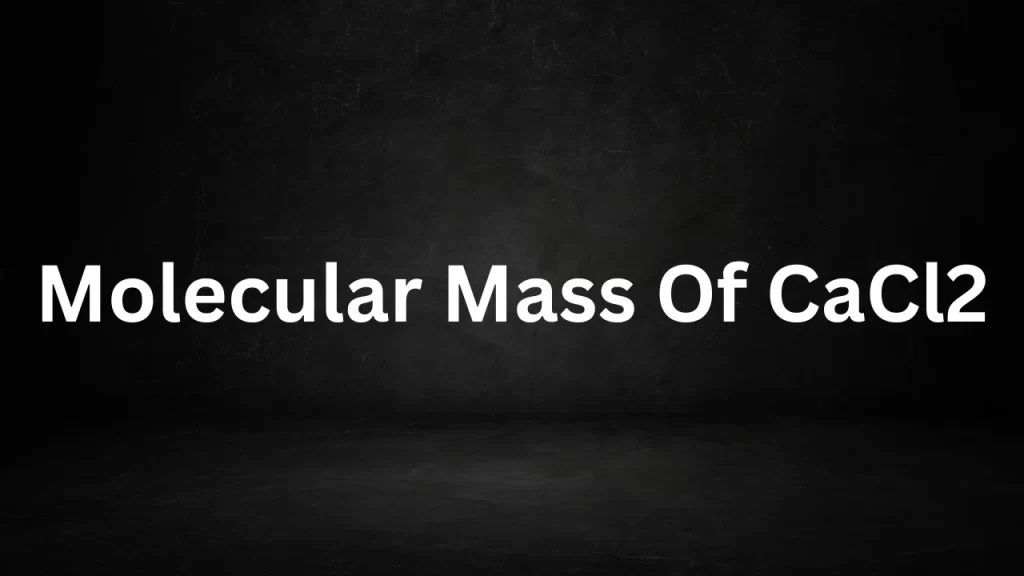Tag: molecular weight cacl2 2h2o
Molecular Mass Of CaCl2
Molecular Mass Of CaCl2: Calcium chloride (CaCl2) is a chemical compound that plays a significant role in various industrial, scientific, and everyday applications. To understand its properties and behaviors in chemical reactions, it’s essential to explore its molecular mass.
In this article, we will delve into the world of calcium chloride’s molecular mass, its significance, and practical applications.

Molecular Mass Of CaCl2
The Chemical Formula of Calcium Chloride
Before discussing the molecular mass, let’s establish the chemical formula for calcium chloride. Calcium chloride is composed of one calcium (Ca) atom and two chlorine (Cl) atoms, making its chemical formula CaCl2. This formula indicates the relative proportions of each element in the compound.
Atomic Structure of Calcium and Chlorine
To understand calcium chloride’s molecular mass, we must account for the atomic masses of calcium (Ca) and chlorine (Cl). Calcium possesses an atomic number of 20 and an atomic mass of approximately 40.08 amu. Chlorine, having an atomic number of 17, has an atomic mass of around 35.45 amu. It’s important to note that these atomic masses are averages that consider the naturally occurring isotopes of each element.
Molecular Mass of Calcium Chloride (CaCl2)
To calculate the molecular mass of calcium chloride (CaCl2), we add the atomic masses of each element present in the compound:
Molecular Mass of CaCl2 = (Atomic Mass of Ca) + (2 x Atomic Mass of Cl) Molecular Mass of CaCl2 = (40.08 amu) + (2 x 35.45 amu) Molecular Mass of CaCl2 = 40.08 amu + 70.90 amu Molecular Mass of CaCl2 = 110.98 amu
So, the molecular mass of calcium chloride (CaCl2) is approximately 110.98 atomic mass units (amu).
Significance of Molecular Mass
Understanding the molecular mass of calcium chloride is essential for various reasons:
- Stoichiometry: Molecular mass plays a critical role in stoichiometric calculations, helping chemists determine the quantities of reactants and products in chemical reactions involving calcium chloride.
- Formulation and Manufacturing: Industries use calcium chloride in various formulations and manufacturing processes, where the precise measurement of its molecular mass ensures accurate ingredient proportions.
- Analytical Chemistry: In analytical chemistry, molecular mass is crucial for identifying and quantifying calcium chloride in samples, facilitating quality control and research.
- De-icing and Dust Control: Calcium chloride is widely used for de-icing roads and controlling dust on unpaved surfaces. Understanding its molecular mass is crucial for calculating the appropriate application rates.
Conclusion
The mole mass of calcium chloride, about 110.98 amu, is a fundamental and significant concept in the realms of chemistry and industry. and research. It facilitates accurate measurements in chemical reactions, quality control, and various applications where calcium chloride plays a pivotal role. A clear understanding of its molecular mass is essential for harnessing the compound’s diverse capabilities in our modern world.
Read More
- Molecular Mass Of Mg
- Molecular Mass Of Iodine
- Molecular Mass Of Sugar
- Molecular Mass Of Copper
- Molecular Mass Of Cl2
Frequently Asked Questions (FAQs) On Molecular Mass Of CaCl2
1. What is the molecular mass of calcium chloride (CaCl2)?
The mole mass of calcium chloride (CaCl2) is approximately 110.98 atomic mass units (amu).
2. How is the molecular mass of calcium chloride calculated?
The mole mass of CaCl2 is determined by adding the atomic masses of its constituent elements: calcium (Ca) and chlorine (Cl). For CaCl2, you add the atomic mass of Ca to two times the atomic mass of Cl.
3. Why is the molecular mass of calcium chloride important in chemistry?
The molecular mass is crucial for stoichiometry and helps chemists calculate the amounts of reactants and products in chemical reactions involving calcium chloride.
4. What are the atomic masses of calcium (Ca) and chlorine (Cl)?
The atomic mass of calcium (Ca) is approximately 40.08 amu, while the atomic mass of chlorine (Cl) is around 35.45 amu.
5. Are there any common uses of calcium chloride in everyday life?
Yes, calcium chloride is used for various purposes, including as a de-icing agent for roads in winter, a desiccant to absorb moisture, and in food processing, particularly in cheese making.